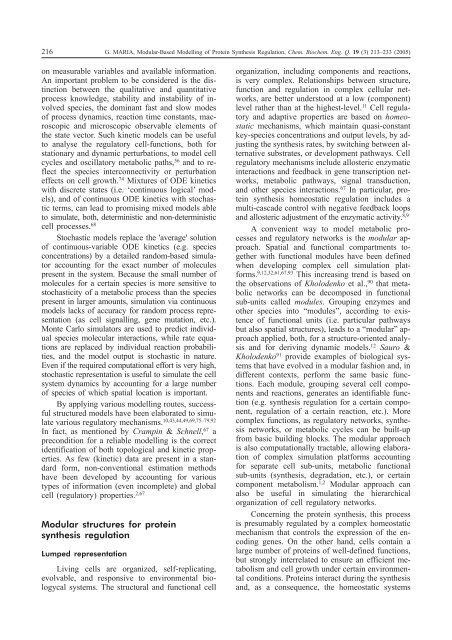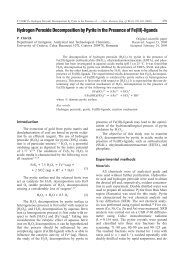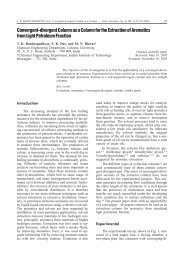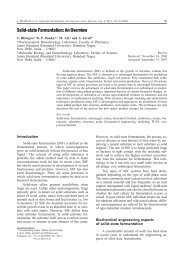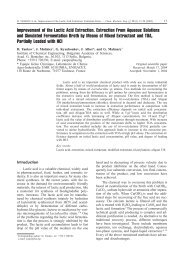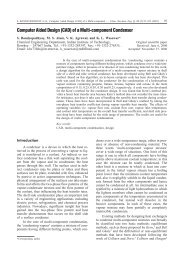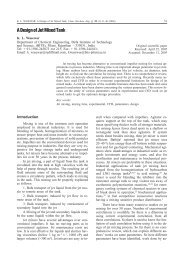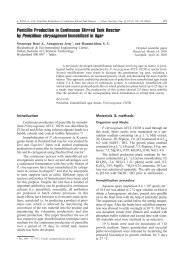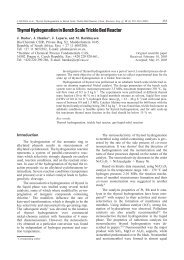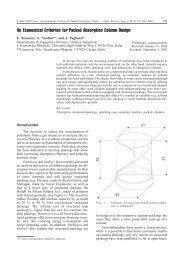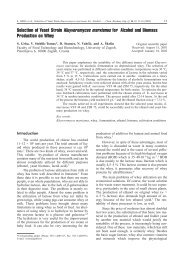Modular-Based Modelling of Protein Synthesis Regulation
Modular-Based Modelling of Protein Synthesis Regulation
Modular-Based Modelling of Protein Synthesis Regulation
You also want an ePaper? Increase the reach of your titles
YUMPU automatically turns print PDFs into web optimized ePapers that Google loves.
216 G. MARIA, <strong>Modular</strong>-<strong>Based</strong> <strong>Modelling</strong> <strong>of</strong> <strong>Protein</strong> <strong>Synthesis</strong> <strong>Regulation</strong>, Chem. Biochem. Eng. Q. 19 (3) 213–233 (2005)<br />
on measurable variables and available information.<br />
An important problem to be considered is the distinction<br />
between the qualitative and quantitative<br />
process knowledge, stability and instability <strong>of</strong> involved<br />
species, the dominant fast and slow modes<br />
<strong>of</strong> process dynamics, reaction time constants, macroscopic<br />
and microscopic observable elements <strong>of</strong><br />
the state vector. Such kinetic models can be useful<br />
to analyse the regulatory cell-functions, both for<br />
stationary and dynamic perturbations, to model cell<br />
cycles and oscillatory metabolic paths, 56 and to reflect<br />
the species interconnectivity or perturbation<br />
effects on cell growth. 74 Mixtures <strong>of</strong> ODE kinetics<br />
with discrete states (i.e. ‘continuous logical’ models),<br />
and <strong>of</strong> continuous ODE kinetics with stochastic<br />
terms, can lead to promising mixed models able<br />
to simulate, both, deterministic and non-deterministic<br />
cell processes. 68<br />
Stochastic models replace the 'average' solution<br />
<strong>of</strong> continuous-variable ODE kinetics (e.g. species<br />
concentrations) by a detailed random-based simulator<br />
accounting for the exact number <strong>of</strong> molecules<br />
present in the system. Because the small number <strong>of</strong><br />
molecules for a certain species is more sensitive to<br />
stochasticity <strong>of</strong> a metabolic process than the species<br />
present in larger amounts, simulation via continuous<br />
models lacks <strong>of</strong> accuracy for random process representation<br />
(as cell signalling, gene mutation, etc.).<br />
Monte Carlo simulators are used to predict individual<br />
species molecular interactions, while rate equations<br />
are replaced by individual reaction probabilities,<br />
and the model output is stochastic in nature.<br />
Even if the required computational effort is very high,<br />
stochastic representation is useful to simulate the cell<br />
system dynamics by accounting for a large number<br />
<strong>of</strong> species <strong>of</strong> which spatial location is important.<br />
By applying various modelling routes, successful<br />
structured models have been elaborated to simulate<br />
various regulatory mechanisms. 10,43,44,49,69,75–79,92<br />
In fact, as mentioned by Crampin & Schnell, 67 a<br />
precondition for a reliable modelling is the correct<br />
identification <strong>of</strong> both topological and kinetic properties.<br />
As few (kinetic) data are present in a standard<br />
form, non-conventional estimation methods<br />
have been developed by accounting for various<br />
types <strong>of</strong> information (even incomplete) and global<br />
cell (regulatory) properties. 2,67<br />
<strong>Modular</strong> structures for protein<br />
synthesis regulation<br />
Lumped representation<br />
Living cells are organized, self-replicating,<br />
evolvable, and responsive to environmental biologycal<br />
systems. The structural and functional cell<br />
organization, including components and reactions,<br />
is very complex. Relationships between structure,<br />
function and regulation in complex cellular networks,<br />
are better understood at a low (component)<br />
level rather than at the highest-level. 11 Cell regulatory<br />
and adaptive properties are based on homeostatic<br />
mechanisms, which maintain quasi-constant<br />
key-species concentrations and output levels, by adjusting<br />
the synthesis rates, by switching between alternative<br />
substrates, or development pathways. Cell<br />
regulatory mechanisms include allosteric enzymatic<br />
interactions and feedback in gene transcription networks,<br />
metabolic pathways, signal transduction,<br />
and other species interactions. 67 In particular, protein<br />
synthesis homeostatic regulation includes a<br />
multi-cascade control with negative feedback loops<br />
and allosteric adjustment <strong>of</strong> the enzymatic activity. 8,9<br />
A convenient way to model metabolic processes<br />
and regulatory networks is the modular approach.<br />
Spatial and functional compartments together<br />
with functional modules have been defined<br />
when developing complex cell simulation platforms.<br />
9,12,32,61,67,93 This increasing trend is based on<br />
the observations <strong>of</strong> Kholodenko et al., 90 that metabolic<br />
networks can be decomposed in functional<br />
sub-units called modules. Grouping enzymes and<br />
other species into “modules”, according to existence<br />
<strong>of</strong> functional units (i.e. particular pathways<br />
but also spatial structures), leads to a “modular” approach<br />
applied, both, for a structure-oriented analysis<br />
and for deriving dynamic models. 12 Sauro &<br />
Kholodenko 91 provide examples <strong>of</strong> biological systems<br />
that have evolved in a modular fashion and, in<br />
different contexts, perform the same basic functions.<br />
Each module, grouping several cell components<br />
and reactions, generates an identifiable function<br />
(e.g. synthesis regulation for a certain component,<br />
regulation <strong>of</strong> a certain reaction, etc.). More<br />
complex functions, as regulatory networks, synthesis<br />
networks, or metabolic cycles can be built-up<br />
from basic building blocks. The modular approach<br />
is also computationally tractable, allowing elaboration<br />
<strong>of</strong> complex simulation platforms accounting<br />
for separate cell sub-units, metabolic functional<br />
sub-units (synthesis, degradation, etc.), or certain<br />
component metabolism. 1,2 <strong>Modular</strong> approach can<br />
also be useful in simulating the hierarchical<br />
organization <strong>of</strong> cell regulatory networks.<br />
Concerning the protein synthesis, this process<br />
is presumably regulated by a complex homeostatic<br />
mechanism that controls the expression <strong>of</strong> the encoding<br />
genes. On the other hand, cells contain a<br />
large number <strong>of</strong> proteins <strong>of</strong> well-defined functions,<br />
but strongly interrelated to ensure an efficient metabolism<br />
and cell growth under certain environmental<br />
conditions. <strong>Protein</strong>s interact during the synthesis<br />
and, as a consequence, the homeostatic systems


